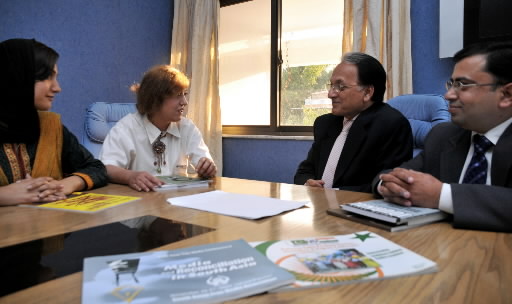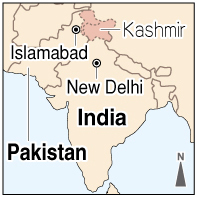Nuclear weapons can be eliminated: Chapter 2, Part 6
Apr. 22, 2009
Chapter 2: South Asia’s cold war
Part 6: Role of the news media
by Junichiro Hayashi, Staff Writer
News articles foster spirit of peace
The South Asian Free Media Association (SAFMA), a group of journalists working to build peace, has its offices in Islamabad, the capital of Pakistan. Formed in 2001, the association has more than 10,000 members from eight countries in the region.
When we visited him in their offices, Mustansar Javed, 63, editor in chief of a local newspaper, proudly described a major success the group had achieved.
In late November 2008, the Hindustan Times sponsored a Leadership Summit in New Delhi in which representatives of Pakistan participated via a teleconference system. When asked if Pakistan would adopt a policy of no first use, President Asif Ali Zardari said, “Most definitely.”
Although India announced a nuclear doctrine including a policy of no first use in 2003, this was the first such statement by a head of state of Pakistan, and it was widely reported by news media around the world.
In the SAFMA office we met Ashfaq Mirza, 64, a freelance Pakistani journalist who heard an account of the atomic bombing from a Hiroshima resident who visited Pakistan in the 1960s.
Pakistan has been under a military regime for most of the time since the partitioning of India in 1947. Restrictions on the news media were particularly harsh in the 1980s. Not only were anti-government reports repressed, reporters were sometimes also arrested. “Now we can meet with politicians and report freely,” Mr. Mirza said. “I want to take full advantage of my position to lead the nation on the path to peace.”
In 2004, Mr. Javed and nine other SAFMA members went to Kashmir, where India and Pakistan are engaged in an ongoing conflict over its possession. After returning to Pakistan, they suggested to the president that more contact between the people of the two nations would form the basis for peace. The following April, buses began operating in Kashmir. “Each effort eases the tensions that threaten the peace between the two nations,” Mr. Javed said.
In India’s capital of New Delhi, we met Kuldip Nayar, 84, a reporter who was born in what is now Pakistan but moved to India after the 1947 partition. He has served as a member of the upper house of Parliament.
“Nothing can be done about nuclear weapons or the Kashmir problem until we eliminate the anti-India and anti-Pakistan sentiments of the citizens of the two countries,” he said. Sitting behind a desk covered with papers, he smiled: “Economic interaction and cultural exchange… The mass media will foster public opinion creating ties between the two countries, and the government won’t be able to ignore it.”
In late February, under the auspices of a plan formulated by SAFMA, 13 Indian journalists visited Pakistan and met with government officials and politicians. Cane in hand, Mr. Nayar went as leader of the group.
(Originally published on March 26, 2009)
To comment on this article, please click the link below. Comments will be moderated and posted in a timely fashion. Comments may also appear in the Chugoku Shimbun newspaper.









